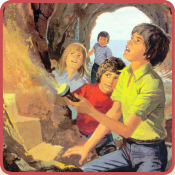
My Enid Blyton Bedside Book

Book Details...
First edition: 1949
Publisher: Arthur Barker
Cover Art: Whyte
Illustrator: listed with stories
Category: Barker Bedside Books
Genre: Mixed
Type: Short Story Series Books
Publisher: Arthur Barker
Cover Art: Whyte
Illustrator: listed with stories
Category: Barker Bedside Books
Genre: Mixed
Type: Short Story Series Books
On This Page...
- The Little Policeman
Illustrations: Douglas Cuthill
Story: Sunny Stories No.254 Nov 21, 1941 - Betsy-May and the Giant-Boy
Illustrations: Whyte
Story: Sunny Stories No.318 Dec 31, 1943 - It's Really True!
Illustrations: J.B. Prentice
Story: Sunny Stories No.320 Jan 28, 1944 - Mrs. Doodle Loses Her Head
Illustrations: John Dugan
Story: Sunny Stories No.319 Jan 14, 1944 - The Surprising Cap
Illustrations: Whyte
Story: Sunny Stories No.240 Aug 15, 1941 - Sammy and the Spider
Illustrations: John Dugan
Story: Sunny Stories No.248 Oct 10, 1941 - The Rough Little Boy
Illustrations: Douglas Cuthill
Story: Sunny Stories No.242 Aug 29, 1941 - The Girl Without a Fancy-Dress
Illustrations: Whyte
Story: Sunny Stories No.297 Mar 12, 1943 - Robin's Watering-Can
Illustrations: W.M.C.
Story: Sunny Stories No.323 Mar 10, 1944 - The Lost Baby Mouse
Illustrations: J.B. Prentice
Story: Sunny Stories No.239 Aug 8, 1941 - The Meddlesome Golliwog
Illustrations: Whyte
Story: Sunny Stories No.323 Mar 10, 1944 - The Well-Mannered Scarecrow
Illustrations: J.B. Prentice
Story: Sunny Stories No.249 Oct 17, 1941 - Simple Simon and the Goat
Illustrations: Whyte
Story: Sunny Stories No.326 Apr 21, 1944 - The Last Page of All
Illustrations: Whyte
Poem: Specially Written

Wraparound dustwrapper from the 1st edition, illustrated by Whyte

Dustwrapper from the 4th impression 1956, illustrated by Whyte

Cloth boards of the 1st edition

Endpapers fron the 1st edition, illustrated by J.B. Prentice

Contents page from the 1st edition
Sure enough, the first tale is – The Little Policeman. For his eighth birthday, George receives a policeman's outfit complete with helmet, a notebook and a pencil. He looks very grand and he feels very important when, in full uniform, he takes a walk into the village and is seen by the other children. The story deals with George's observations when he spots something strange and, like the good policeman he is, he makes notes and they come in handy after a crime is committed. Real policemen come into the story at the end and George's diligence reaps him a wonderful reward.
Betsy-May is a familiar name to Blytonites. She was about six in 1940, so she'd be in her seventies these days but Enid Blyton's characters rarely change due to the immortality granted them. Betsy-May has a guest role in this book and she sees a giant boy looking at her from over the high wall of the house adjoining hers. When she's invited to tea at the giant's place you can imagine her reluctance because small kids can be rather frightened of unusual people.
The story beginning on Page #42 has a familiar theme ... an Enid Blyton explanation for one of nature's occurrences, and after that we're introduced to a character who'd be well placed in a Rubbalong tale. Her name is Mrs. Doodle and the title tells us what happens when a little magic is flicked around. The next story shows us that if you possess bad manners in an Enid Blyton book your deficiency will have to be corrected no matter how old-fashioned the concept. Come to think of it are males still meant to raise their hats when they stop to talk to a lady? Harry's expected to anyway but he hasn't got into the habit of lifting his cap yet so a humorous twist is introduced to impart a lesson. On to the next tale and when I read about Sammy and the Spider I felt for him (Sammy, not the spider) because John Dugan, the accredited illustrator, has drawn a monster that should scare any kid – it certainly scared me when I first saw it. Despite his fear of spiders, Sammy's a good boy and means well so he tries to conquer his fear and we all know that he's sure to be rewarded in the end because that's what we expect.
Anna was one of my favourites when I was about seven and in The Rough Little Boy she has a hard time because of Thomas. Running off to have tea with her Auntie Susan and wearing her lovely new hair-ribbon, she clutches in her hand a bead necklace that she has made as a gift for her aunt. Thomas, a local urchin, confronts the girl and subjects her to a little bullying because he has nothing better to do and Anna is no match for him seeing she's a girl and can't match his strength. After feeling so happy when she set off on her journey she's now reduced to tears as the ribbon is snatched from her hair and the lovely bead necklace is torn apart. There's plenty of emotion in this narrative and it's one I read many times.
In the next story about a fancy dress, Enid Blyton uses a situation that has been duplicated at least once. When Eileen is invited to a party she's very sad because she has nothing fancy to wear but in the time between leaving her house and arriving at the party fate smiles upon her – negatively, and then positively. Judging by the final picture I think the children would have really enjoyed themselves at the get-together. Robin's Watering Can is another tale with a familiar pitch and once we see a picture of a robin (no capital) we can perhaps work out what's going to happen.
A little mouse and an aggressive cat are the next on offer. Very fortunately the mouse meets up with some friendly toys and is saved from sure destruction. The Meddlesome Golliwog decides to have a go at flying the resident kite and one might think that the kite would love to sail up into the air on a windy day but in this case there's apprehension. The golliwog didn't get the name "meddlesome" for nothing. However, once the kite finds itself being buffeted by the strong breeze, the desire to reach the clouds become so urgent that it shoots skyward with zest and pulls the golly up as well! What a calamity! The things that happen to the golliwog after that would hardly happen to the unluckiest person in the world. Utter degradation is on the menu and then another Enid Blyton specialty is introduced to finish the story off – a gender change!
As opposed to the golliwog above, the scarecrow who stars in the next story must be the luckiest of his kind ever because he gets to raise his hat to the Queen! Admittedly, the personage that appears amongst him and his brownie friends doesn't look anything like her Majesty Queen Elizabeth the Second of Great Britain and Northern Ireland but her presence radiates beauty and fairylike qualities. The main picture looks quite bizarre in its own way but one can't help feeling drawn towards the scarecrow who does his very best to honour the moment of "Fame" that has descended upon his ragged life.
In the final story we meet up with Simon again. Simon appears in other Blyton tales and he's not all that bright so people, other than his mother, refer to him as "Simple" Simon. In this story he mistakes a goat for a coat and does with the goat what you'd do with a coat but the goat objects to being treated like a coat and this all happens just when Simon had started his day off quite sensibly for once. The boy receives due punishment!
Regarding the introduction - English houses enjoyed the benefits of electricity in the Forties of course but in this particular case there was a power cut.
I enjoyed the book immensely when I first read it. The quality of the tales ensures interest and the preponderance of pictures is an enhancement. I think the publishers went out of their way to make the presentation as attractive as they could because even the front and back endpapers contain large illustrations in a kind of monochrome and they can be seen with all the others in the Cave of Books.
Again, I wonder how many Blyton characters sported the name "Harry."
The last page of all features a poem entitled The Last Page of All and the time scale would place it a few moments before the picture on the wrapper of the girl sitting up in bed.
Like many of the Blyton compilations, the Bedside Books contain poems and puzzles as well and in this particular volume there's a good variety that children (and even grown-ups) will enjoy.
Many Enid Blyton titles are similar sounding so it can become a little confusing when you dig up Enid Blyton's Bedside Book No.13. I said there were twelve! In the Sixties, a series of compilations were published with the title – Enid Blyton's Bedside Book – Numbers 1 to 20 (you can see pictures of all in the Cave of Books). They contain several short stories taken from various reprints of reprints particularly EB's Bedtime Annual and at least one tale has been filched from the Twelfth Bedside Book (this series). There's a subtle difference. Taking the Twelfth of each as examples - the title of the book in this collection (1960) is Enid Blyton's Twelfth Bedside Book, and the late Sixties (1969) example is Enid Blyton's Bedside Book with Number Twelve at the bottom of the cover. Confusion still reins though because the first book (this series) is called My Enid Blyton Bedside Book whilst the rest in the series have the number in the title. Looking at the Twelfth of the earlier series again - if you look inside the flap it's described as 'My Twelfth Enid Blyton Bedside Book' as opposed to Enid Blyton's Twelfth Bedside Book. Terribly important to know this is it not? Not! These revelations are purely for the obsessive collector of trivia.
Several illustrators supplied the pictures and it's hard to pick a favourite because they're all quite good although I wouldn't say they match such artists as Soper, Davies, Wheeler, or McGavin. I'll choose Doug Cuthill just for the sake of it.







 Book 1 of 12 in this category
Book 1 of 12 in this category 